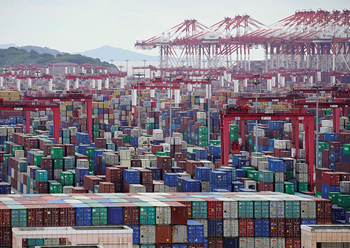
 High demand for container and bulk shipping has seen the value of vessels rise dramatically
High demand for container and bulk shipping has seen the value of vessels rise dramatically
Demand for crew is currently high with the shipping boom, yet following the Covid-19 pandemic many skilled and experienced crew are leaving the industry, having endured many months, and in some cases, years, stuck on vessels. For those that choose to remain, commercial pressures are running high, which can lead to mistakes and shortcuts, says marine insurer Allianz Global Corporate & Specialty SE (AGCS) in its Safety & Shipping Review 2022.
High demand for shipping is also affecting the risk profile of certain sub-sectors, including container shipping. The global fleet is ageing, yet values and exposures are rising. High freight rates are also leading some operators to carry containers on bulk carriers, where crews are not trained or experienced in handling containers, while such vessels are not designed to carry them, the report says.
Crew crisis
Seafarers were the unsung heroes of the pandemic, keeping the world supplied with food, energy, raw materials and manufactured goods. Yet, Covid-19, and now Russia’s invasion of the Ukraine, has taken its toll on the industry’s workforce.
 |
|
Captain Rahul Khanna |
Covid-19 restrictions and travel bans meant hundreds of thousands of crew members were stranded on ships, some for years. At its peak in 2020, it was thought that up to 400,000 seafarers were unable to be repatriated, falling to 200,000 in 2021. The Covid-19 crew crisis is now largely over, but the experience is likely to have long-lasting effects.
“The health and wellbeing of crew has always been a critical factor in safety,” says Captain Rahul Khanna, Global Head of Marine Risk Consulting at Allianz Global Corporate & Specialty (AGCS). “However, morale among seafarers is currently low and the pandemic has had an impact on the mental health and well-being of crew. Now crews face a rising workload, while the ever-growing burden of compliance is making the job less attractive.”
In what has been termed the ‘great resignation’, the pandemic prompted many workers to rethink their work life balance, with some choosing to retire or switch careers. The combination of the pandemic and current working conditions risks a future skill shortage for the shipping industry, according to Captain Nitin Chopra, Senior Marine Risk Consultant at AGCS.
Crew welfare and retention rate is a risk factor considered in underwriting, explains Justus Heinrich, Global Product Leader Marine Hull at AGCS. “Our major clients have crew retention programs and we see a lot of investment in attracting and retaining crew, as well as welfare management,” says Heinrich. “From the perspective of our risk assessment, we like to see high levels of crew retention and evidence of good people risk management. Particularly with more modern vessels and technology, the ability to attract and retain experienced crew is critical.”
Russia’s invasion of Ukraine has further ramifications for a global maritime workforce already facing shortages. Russian seafarers account for just over 10 per cent of the world’s 1.89 million seafarers, while around 4 per cent are from Ukraine.
 |
|
Justus Heinrich |
With many direct flights to Russia suspended, and with fewer vessels calling at Russian and Ukrainian ports, seafarers from these countries may struggle to return home or re-join ships at the end of the current contracts. Ultimately, seafarers in the Black Sea are in a perilous situation, stuck onboard vessels or in ports with dwindling supplies and under fire, which is yet another blow for the industry and global supply chains, given crew levels have not yet returned to normal levels.
Regular crew changes are required across the world to ensure the flow of manpower is maintained. Last year, the International Chamber of Shipping and shipping trade association Bimco warned there could be a “serious shortage” of officers within five years if action is not taken to increase training and recruitment levels. The report predicted that there will be a need for an additional 89,510 officers by 2026, yet there was a shortfall of 26,240 certified officers in 2021.
Increased exposures
The economic rebound from Covid-19 lockdowns has created a boom time for shipping, with huge increases in charter and freight rates. While higher rates are a positive for many in the industry’s finances, changing the use of vessels to take advantage of this, and extending the working life of ships raises warning flags for underwriters.
High demand for container and bulk shipping has seen the value of vessels rise dramatically, while charter and freight rates have skyrocketed. Charter rates in the container and LNG markets hit an all-time high last year, and a decade high in the dry bulk market, while values remain well above historical averages, according to VesselsValue.
The value of a five-year old Panamax boxship more than tripled from $22 million in January 2020 to $82 million a year later. Charter rates for a Panamax have increased 274 per cent over the same period. Last year also saw record values for bulkers, with a five-year old Supramax increasing in price by 46 per cent from $19 million to $27 million.
In addition, the International Monetary Fund has warned that the invasion of Ukraine by Russia in February will exacerbate already high shipping costs and keep them – and their inflationary effects – higher for longer.
“Rising values and charter rates have created a mismatch for insurers,” explains Captain Anastasios Leonburg, Senior Marine Risk Consultant at AGCS. “Older vessels now command higher values, while the accumulation risks have increased with larger vessels and more value on board. This results in a significant increase in the risk profile, which is not necessarily reflected in premium.”
Port congestion
Covid-19 measures in China, a surge in consumer demand and the invasion of Ukraine have all been factors in ongoing unprecedented port congestion.
Congestion at the US ports of Los Angeles and Long Beach reached record levels in November 2021, with 116 container ships either in port or at anchor, while in March 2022, Los Angeles recorded its third-busiest month ever as work continued to clear marine terminals of cargo and reduce the number of ships waiting at sea.
At the same time, repeated outbreaks in China, resulting in the staggered lockdown of Shanghai in March/April 2022 for example, and Russia’s invasion of Ukraine is compounding ongoing supply/ demand pressures for shipping, which have resulted in port congestion, higher freight fees and longer transit times.
Overall, port congestion globally is running above the levels seen last year, with specific container fleet congestion trending towards previous highs, Clarksons Research noted in March 2022, while the impacts of the invasion are likely to create further inefficiencies across the maritime transport system.
Port congestion puts crews, port handlers and facilities under additional pressure, increasing risk at a critical stage of a ship’s journey, according to Captain Leonburg.
Cyber threat
As geopolitical risks rise, so does the prospect of malicious digital disruption.
The shipping industry continues to fall victim to cyber-attacks. In February 2022, a container terminal at Jawaharlal Nehru Port Trust, India’s busiest container port, was hit by a ransomware attack. It is just the latest to be affected, following ransomware incidents at US and South African ports in recent years. Earlier this year, a number of European oil terminals were also affected by a cyber-attack.
Cyber criminals have also targeted shipping and logistics companies. US-based freight forwarder Expeditors was hacked in February, 2022, while Hellmann Worldwide Logistics suffered a ransomware attack in December last year that disrupted operations for weeks. In recent years, some of the world’s largest shipping companies – Maersk, Mediterranean Shipping Company, Cosco and CMA CGM have all been targeted.
According to a recent industry survey just under half (44 per cent) of maritime professionals reported that their organization has been the subject of a cyber-attack in the last three years. Of these, 3 per cent agreed to pay a ransom, which averaged at around $3 million. It also found 32 per cent of organizations do not conduct regular cyber security training while 38 per cent do not have a cyber response plan.














